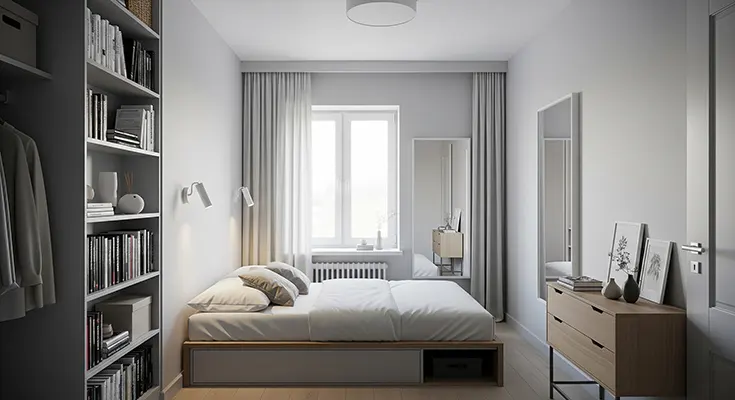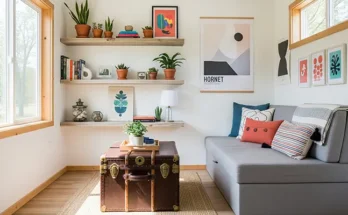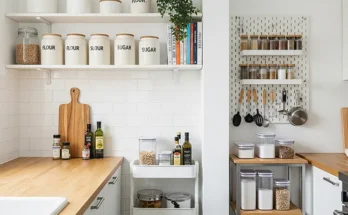A small bedroom with a low ceiling can feel cozy, but it often borders on feeling cramped or cave-like. The key to maximizing both space and perceived height is to employ strategic design tricks that draw the eye upward and utilize every available inch for efficient storage.
By focusing on furniture scale, intelligent lighting, and visual illusions, you can transform your vertically-challenged room into an airy, restful, and functional retreat.
1. Optimize Furniture for Low Clearance
The goal is to create as much empty space between the furniture and the ceiling as possible.
- Go Low with the Bed: Ditch the tall headboard and bulky box spring. Opt for a low-profile platform bed or a simple frame that sits close to the floor. This single change instantly increases the visual distance to the ceiling, creating an immediate sense of height.
- Embrace Floating and Multi-Functional Pieces:
- Replace traditional nightstands with floating shelves or slim, wall-mounted tables. This frees up floor space and leaves the area beneath the furniture open, which makes the room feel larger.
- Choose a bed frame with built-in storage drawers underneath to eliminate the need for a separate dresser or chest.
- If you need a wardrobe, choose one that is floor-to-ceiling to utilize vertical space completely. The continuous line from floor to ceiling tricks the eye into seeing more height than is actually there.
- Use Open-Legged Furniture: For any pieces that sit on the floor (like a small desk or chest), choose those with visible, high legs. Seeing the floor continue beneath the furniture adds to the feeling of openness.
2. The Art of Vertical Illusion
Designers use clever visual tricks to “raise” the ceiling without any construction.
- Vertical Lines are Your Friend: Introduce elements that emphasize vertical movement:
- Hang Curtains High: Mount the curtain rod as close to the ceiling as possible, letting the fabric fall straight to the floor. This creates a long, continuous vertical line that elongates the wall.
- Vertical Trim or Wallpaper: Consider fine, vertical striped wallpaper or slim, floor-to-ceiling millwork (like picture rail molding or subtle wood paneling) to encourage the eye to move upward.
- Tall, Narrow Artwork: Hang slim artwork or posters vertically, and mount them slightly higher than usual to visually draw the gaze toward the ceiling.
- Mirror Magic: Hang a large, vertical mirror on a wall, ideally opposite a window. Mirrors are masters of illusion, reflecting light and the surrounding space, effectively doubling the size of the room and bouncing light onto the ceiling.
- Color Psychology: Paint the walls a light, bright color (like white, a pale gray, or a soft pastel). For the low ceiling itself, paint it the same color as the walls or a slightly lighter shade. Blurring the line where the wall ends and the ceiling begins prevents the ceiling from feeling like a heavy “lid” on a box.
3. Smart Lighting Strategies
Overhead fixtures can highlight the ceiling’s limits; strategic light placement can dissolve them.
- Ditch the Droop: Avoid chandeliers, traditional pendants, or anything that hangs down into the room.
- Opt for Flush Mounts: Install flush-mount or semi-flush-mount LED fixtures that sit close to the ceiling. Look for sleek, modern designs that offer bright, even light distribution.
- Upward-Facing Light: Utilize wall sconces, floor lamps, or table lamps that direct light up onto the ceiling. Indirect lighting brightens the overhead surface and creates the illusion of height and airiness.
- Focus on Task Lighting: Use adjustable sconces or clip-on lights at the bedside to save space on your nightstand, providing focused light for reading without relying on harsh, central overhead fixtures.
4. Hidden and Vertical Storage
In a small space, every storage solution must work harder.
- Wall-Mounted Shelving: Install floating shelves high on the walls, above eye level, to hold books and decorative items. This keeps clutter off the floor but doesn’t feel oppressive since it’s above your immediate sightline.
- Maximize Closet Space: If a closet exists, install a second hanging rod and floor-to-ceiling shelving to maximize its capacity. Every item hidden behind a closed door makes the room feel instantly more spacious.
- Vertical Zoning: Use tall, slender bookcases that reach near the ceiling. Instead of a wide, short piece, the height will help pull the eye up while providing excellent storage.
By combining low furniture with vertical accents, bright, indirect lighting, and clever hidden storage, your small, low-ceilinged bedroom will not only feel larger but also exude a sophisticated, thoughtful design aesthetic.





